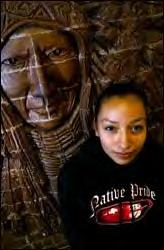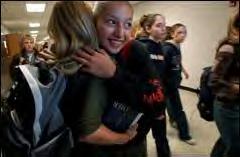|
|
Canku Ota |
|
|
(Many Paths) |
||
|
An Online Newsletter Celebrating Native America |
||
|
November 2, 2002 - Issue 73 |
||
|
|
||
|
Arapaho Redefines 'Home School' |
||
|
by Karen Rouse
Denver Post Staff Writer |
||
|
credits:Post
/ Craig F. Walker
Arapahoe High School freshman Pejuta ‘Buffalo’ Soldier Wolf stands by a relief of the Warrior mascot in the school’s foyer. |
 ARAPAHOE
COUNTY - She is called "Buffalo"
because as a toddler, she was big for her age. ARAPAHOE
COUNTY - She is called "Buffalo"
because as a toddler, she was big for her age. But the name given to her by her elders on the Wind River Indian Reservation in central Wyoming - Pejuta Wastewie Solider Wolf - has proven more prophetic for the 14-year-old. This year she became the first Arapaho Indian to attend Arapahoe High School. "Pejuta means medicine woman," said Mark Soldier Wolf, her 75-year-old grandfather. The medicine woman, according to tribal lore, was a girl who went out on a "vision quest" and, with the guidance of a great spirit, created a potion from medicinal plants that cured her ailing people. "This school is a vision for her," Mark Soldier Wolf said from the sprawling, 2.2 million-acre reservation that is home to more than 6,000 Arapaho. "After she experiences that vision, whatever her interests are it's like the woman in the story. She will come back and help her people." To her schoolmates, Buffalo is an exotic curiosity - a freshman of sweet innocence who wears electric-blue mascara, craves cherry Jolly Rancher candy and has a cool nickname grounded in a mysterious culture. Fourteen-year-old Leah Russell said she "thought it was really cool that (Buffalo) would be willing to come here. "She's very open and understanding that we don't know a whole lot about her culture," Russell said. To her family, Buffalo is a courageous pioneer, the first Arapaho Indian high school student to return to her tribe's "ancient land" to pursue a better life for her people. "It's nice because I took a step forward to represent my tribe in a better way," says Buffalo, wearing a black hooded sweatshirt with the words "Native Pride" emblazoned across the chest and left arm. "I can go back and help to improve the school (on the reservation), help the kids out," she said. Arapaho Indians had established a life in eastern Colorado at the end of the 18th century but eventually were pushed off the land by western expansion and the development of railroads. The government placed the Arapaho Indians on the Wind River Reservation, which they share with the Eastern Shoshone. Arapahoe County took its name from the tribe, but attached an "e" at the end. Buffalo's entry into the high school is the result of a friendship forged between her tribal leaders and Arapahoe principal Ron Booth a dozen years ago. Controversy over sports teams using mascots that offended Native Americans prompted Booth to seek the tribe's permission to continue using the "Warriors" as the high school's mascot. "They wanted proper permission from the people that owned that land," Mark Soldier Wolf recalled. "That was really a great honor." Booth was granted permission, and today, a more authentic image of an Arapaho warrior, wearing a war bonnet and breast plate, hangs throughout the school. And relations between the tribe and school are strong. Since 1992, members of the tribe, including Buffalo, have visited the high school to teach students about Arapaho culture. Last year, shortly after Buffalo performed as a jingle-dress dancer in the opening ceremonies of the Salt Lake City Olympic Games, she asked her grandfather if she could attend Arapahoe High School.
"She said, 'Grandfather, grandmother I'd like to get out and go to a better school away from here,"' Soldier Wolf said. "She said, 'If other foreign students from foreign countries can come into the United States and learn, I want to go to school there."' Cultural differences and fear of discrimination often make Indians reluctant to leave their reservations, said Tammy Mack, manager of recruitment and retention of American Indian students at the University of Wyoming. "It's hard to even get them to go to college," said Mack. "You're asking them to leave a whole culture and family behind." But on a reservation where unemployment is high, Mack said, several high school graduates are pursuing college away from home. They're realizing "they've got to get an education and then come back and help." It hasn't been easy for Buffalo, who has broken away from her tribe at a much earlier age than most students. She admits the work is more challenging, particularly English and History classes, and works with tutors to get up to speed. "I was in school back home but it wasn't as advanced as here, so this is really a challenge for me," she said. Her biggest fear about attending Arapahoe High School was not the work but whether she would face discrimination. At home, she and other Indian athletes have been told to "go back to the reservation," when playing Anglo schools, she said. So far, she said, she has had no such encounters. She said she is honored to attend the school named for her people. "My tribe was here, and to have a school named after them was a high honor," she said. "I feel very comfortable here, knowing this was our land." Other times, she said, it feels "kind of empty" knowing her people were forced off that land. Principal Booth hopes to see other Arapaho students follow Buffalo's example. "It's a good way to help us learn about the people who are different," he said. It is the wish of her grandfather as well. "If you give these Indian kids a chance to learn something, I bet you, these kids can outsmart other students or even be just as good," Soldier Wolf said. "This granddaughter of mine, Pejuta, she can do it."
|
|
|
||
|
|
||
| Canku Ota is a free Newsletter celebrating Native America, its traditions and accomplishments . We do not provide subscriber or visitor names to anyone. Some articles presented in Canku Ota may contain copyright material. We have received appropriate permissions for republishing any articles. Material appearing here is distributed without profit or monetary gain to those who have expressed an interest. This is in accordance with Title 17 U.S.C. section 107. | ||
|
Canku Ota is a copyright © 2000, 2001, 2002 of Vicki Lockard and Paul Barry. |
||
 |
 |
|
|
The "Canku Ota - A Newsletter Celebrating Native America" web site and its design is the |
||
|
Copyright © 1999, 2000, 2001, 2002 of Paul C. Barry. |
||
|
All Rights Reserved. |
||
 Her
school on the reservation "did not have the teachers to educate
girls that are above average intellect," Soldier Wolf said. As
a result, he said, Buffalo struggled through the seventh and eighth
grades.
Her
school on the reservation "did not have the teachers to educate
girls that are above average intellect," Soldier Wolf said. As
a result, he said, Buffalo struggled through the seventh and eighth
grades.